It is impossible to imagine an active and healthy lifestyle without movement. Joints are the most important elements of the musculoskeletal system, which allow a person to move freely and feel full. With age, dystrophic changes appear in the bones and cartilage tissues, painful sensations appear, which signal the onset of the disease.
The hip joint can withstand enormous loads throughout life, so it is not surprising that the most common pathology of ODA is arthritis-arthritis of the hip joint. In this article you will learn what it is, as well as the causes, consequences and methods of dealing with joint dislocation.Characteristics and causes
Coxarthrosis is a chronic inflammatory process of the hip joint, in which the cartilage tissue is prematurely damaged.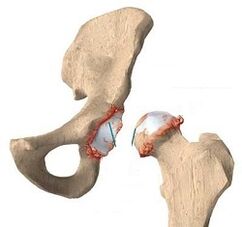
The development of the disease causes the proliferation of osteophytes and the fusion of the acetabulum and the head of the femur, which limits the space of the joints, the joint loses its functionality.
Let us clarify that the joint is the same as the joint disease and the deformed osteoarthritis of the pelvic joint.
The disease can occur as a primary pathology or develop in the context of existing diseases.
Let's look at the main causes of dislocation:
- during active or excessive physical exercise (trauma, minor trauma, overload).
- congenital anomalies (dysplasia, Perthes disease, primary joint deformity)
- inflammation of the pelvis (ankylosing spondylitis, rheumatoid or psoriatic arthritis);
- severe stress (spasm of blood vessels and muscles, aseptic necrosis, hypothermia);
- hormonal disorders?
- ischemic heart disease?
- diseases of the endocrine system (obesity, diabetes).
A complex of health problems leads to the development of dislocation. Most often, the disease is diagnosed in middle-aged and older people, however, with the presence of many factors that cause at the same time, young people and even children are susceptible to arthritis.
Symptoms
In order to respond in time to the development of the pathology, it is important to observe the characteristic symptoms that change as the arthropathy progresses.
The first and most important symptom is pain in the leg, which penetrates the groin, gluteus muscles, sacrum, thigh and knee. The pain intensifies after physical exercise, with prolonged maintenance of standing and sitting position.
Important! At first, the pain may be small and not at all in the pelvis, but, for example, in the knee. This fact complicates the early diagnosis and the correct diagnosis.
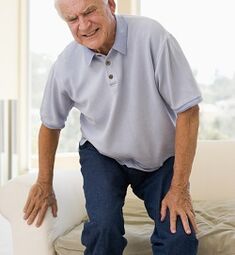
If the disease is not diagnosed in time, the patient will experience symptoms of a hip joint such as:
- severe groin pain when walking or leaning on the leg.
- painful, rough seizures when moving the hip to the side and walking (not to be confused with clicking, which is inherent in most healthy people).
- joint stiffness, limited mobility of the legs
- gait change, lameness, duck gait?
- reduction or lengthening of the limbs.
- muscle atrophy?
- Fastening legs in one place (anchorage).
An important diagnostic sign of dislocation is the physical limitations when it bends forward, abducting the hip to the side.
A patient with this diagnosis finds it difficult to tie the strings on their own, to sit with their feet apart and to sit deep.
There are 3 degrees of osteoarthritis of the acetabulum and femoral head, characterized by gradual destruction of the joint. Let's look at their features below.
Stage 1 of the joint is characterized by a slight destruction of the cartilage, the joint space is slightly limited.
By the second stage, the destruction of cartilage tissue increases significantly, the first signs of the disease begin to bother: pain, stiffness.
More severe damage to the hip joint occurs in 3 stages. It is characterized by deep cartilage destruction, bone deformity, pain at rest. The disease completely destroys the cartilage and deforms the thigh.
The joint loses its mobility, the leg is stable and serves as a support. In this case, conservative treatment is powerless; joint replacement surgery is required.
Diagnostics
The diagnosis of the disease shows how badly the cartilage is affected and whether hip joint arthropathy can be cured.
The success of treatment depends on when treatment was started.
Note. The last stage of dislocation does not respond to conservative treatment and requires surgery. Diagnosis and treatment of the disease from the beginning of the disease increases the chances of recovery.
To make a diagnosis, an external examination is performed, the degree of mobility of the hip joint, changes in gait and leg length are assessed. X-rays, CT scans and MRIs are prescribed to confirm the primary joint. If the patient requires surgery, urine, stool, blood, and joint fluid are taken extra.
Treatment of diseases
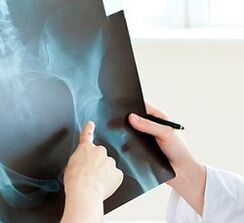
Coxarthrosis is a progressive disease. It is impossible to cure it once, such as acute respiratory infections and forget the condition of your joints.
Successful treatment of grade 1, 2, and 3 hip joint deformity requires a comprehensive approach that combines therapeutic exercises, medications, physiotherapy, and lifestyle changes.In extreme cases, the patient should resort to surgical treatment of the joint. The method of treatment depends on the degree of the disease.
Medicines
The first thing prescribed to a patient diagnosed with osteoarthritis is non-steroidal anti-inflammatory drugs. They act directly on the site of inflammation and provide symptomatic treatment.
Note! It is important to observe the dosage and duration of the course indicated by the doctor. Uncontrolled use of NSAIDs leads to side effects.
For the treatment of joint dislocation, vasodilators are also prescribed. They are necessary to increase blood flow to the diseased joint, to enhance the nutrition of cartilage.
Cartilage protectors are used to restore the mobility of cartilage and joint tissues. Glucosamine and chondroitin sulfate are substances that stimulate the production of new structural cells and inhibit the action of enzymes that destroy cartilage tissue.
Massage
Manual massage for healing or rehabilitation is passive exercise for the affected joints. Thanks to the massage movements, the blood circulation and lymphatic drainage are improved, the muscles are strengthened, the ligaments and tendons become more elastic. This approach to treatment helps reduce pain, enhance the effect of medication, and reduce the need for medication.
Important! Massage should only be done by a qualified professional. Careless movements will cause even more pain and injury to the joint.
Physiotherapy exercises
Movement is the basis of life. Exercise for osteoarthritis of the hip bones aims to restore cartilage nutrition and joint mobility, strengthening the muscular corset.
Performing therapeutic exercise regularly reduces foot discomfort when walking.
Exercise allows you to deal with hip pain at home.
All movements are aimed at treating and preventing stages 1 and 2 of osteoarthritis of the hip joints.
Before you start exercising, make sure there are no contraindications to exercise:
- hypertension?
- critical days?
- infectious diseases?
- increased body temperature.
- the recovery period after surgery on the abdominal and chest organs.
- inguinal and umbilical hernia?
- intervertebral disc herniation?
- acute inflammatory processes of internal organs or exacerbation of chronic diseases.
- serious diseases of the cardiovascular and circulatory system.
If a movement during exercise causes severe pain, it probably does not suit you, so it is best not to do it and exclude it from the band.
Diet
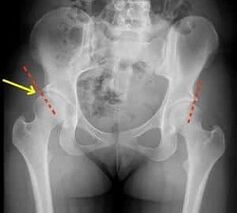
Nutritional therapy for hip joints aims to reduce and maintain a normal weight.
Being overweight increases stress on the spine and joints, creating an additional risk of developing musculoskeletal disorders.
The basis of the diet is the moderate intake of food rich in vitamins and minerals. Foods must be whole and contain the necessary structural elements of cells: proteins, carbohydrates, fats.
You should prefer plant foods: nuts, seeds, leafy vegetables, seasonal vegetables and fruits, lean meats and fish, low-fat dairy products, legumes and cereals.
Cow's milk is best consumed in moderation.
Fats, spicy, smoked, canned, fried, pickled, unfinished products, alcohol, coffee should be excluded from the diet.
Bad habits (smoking, drug addiction, overeating) should also be eliminated from your lifestyle, as they wear down the body, exposing it to premature aging.
How to get rid of pain with folk remedies
Homeopathy for hip joint replacement is one of the alternative treatment methods. Based on natural ingredients, homeopaths create drugs that aim to treat pathologies of internal organs and the human skeleton. The peculiarity of homeopathic preparations for arthropathy is that they are able to restore the balance between the destruction of cartilage by enzymes and the renewal of its tissues.
Attention! Before treating a hip joint at home, you should be diagnosed with the disease. It is important not to aggravate the condition, as this can cost a person the ability to walk.
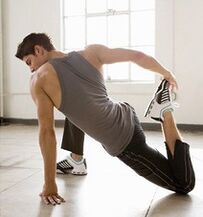
Homeopathic remedies, injections and ointments for the treatment of joints are selected based on the natural conditions of the environment and the location of the disease.
Before using any medicine, you should consult a doctor!
Prevention
People with a predisposition to this pathology should avoid stress, injuries, treat infectious diseases in a timely manner, exercise regularly, eat well and get enough sleep.
If you feel discomfort in your legs, it is recommended that you contact an orthopedist immediately for diagnosis and treatment.
Conclusion
Osteoarthritis of the hip joints is most often affected by people over the age of 45, athletes and children with congenital limb pathologies. The disease destroys and deforms the joint, the person experiences excruciating pain in the legs. Successful treatment of joint disease requires the inclusion of therapeutic exercises, medication, correction of the patient's lifestyle and weight, and manual therapy.Attention to health is the key to joint longevity! Do not postpone a visit to the orthopedist at the first symptoms of the disease.












































